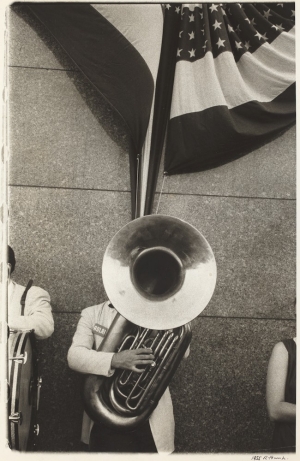The Americans, 1955–1957
In October of 1958, French publisher Robert Delpire released Les Américains in Paris. The following year Grove Press published The Americans in New York with an introduction by Jack Kerouac (the book was released in January 1960).
Like Frank's earlier books, the sequence of 83 pictures in The Americans is non-narrative and nonlinear; instead it uses thematic, formal, conceptual and linguistic devices to link the photographs. Unlike Peru, in which the order of pictures was not firmly established, The Americans displays a deliberate structure, an emphatic narrator, and what Frank called a "distinct and intense order" that amplified and tempered the individual pictures.
Although not immediately evident, The Americans is constructed in four sections. Each begins with a picture of an American flag and proceeds with a rhythm based on the interplay between motion and stasis, the presence and absence of people, observers and those being observed. The book as a whole explores the American people—black and white, military and civilian, urban and rural, poor and middle class—as they gather in drugstores and diners, meet on city streets, mourn at funerals, and congregate in and around cars. With piercing vision, poetic insight, and distinct photographic style, Frank reveals the politics, alienation, power, and injustice at play just beneath the surface of his adopted country.
Since its original publication, The Americans has appeared in numerous editions and has been translated into several languages. The cropping of images has varied slightly over the years, but their order has remained intact, as have the titles and Kerouac's introductory text. The book, fiercely debated in the first years following its release, has made an indelible mark on American culture and changed the course of 20th-century photography.
Selected prints from The Americans
The 81 contact sheets containing frames that were published in The Americans offer insight into Frank's working method by allowing the viewer to, in a sense, look over the photographer's shoulder as he pursues his subjects. Sometimes, he took several shots of a scene at barely distinguishable angles, in search of the ideal arrangement. But often he responded immediately and intuitively to rapidly changing events to produce a brilliant, spontaneous photograph of a fleeting subject.
Collection search (illustrated): The Americans contact sheets
Most of The Americans contact sheets contain several frames marked by Frank with red or black squares, arrows, question marks, or X's. Sometimes whole strips are marked with roman numerals, or lines across a frame indicate a potential crop. These marks reveal another aspect of Frank's artistry: the discerning eye that succeeded in narrowing down over 20,000 pictures to the 83 that would ultimately be published. Often, Frank printed several work prints from a single contact sheet, many of which were rejected and have never been published or exhibited.
Selected contact sheet, work print, and final print sequences
The sequences illustrated below begin with the contact sheet, then show work prints in the order in which they appear on the contact sheet, and then the final print, if in the Collection.
Americans 18/19
Americans 29
Americans 35
Americans 36
Americans 42
Americans 58
Americans 61
Americans 79
About the 2009 exhibition, Looking In: Robert Frank's The Americans
Elson lecture, 2009: Robert Frank (Audio)
In this podcast of the annual Elson Lecture, recorded on March 26, 2009, Robert Frank speaks with curator Sarah Greenough about his career before, during, and after The Americans.

